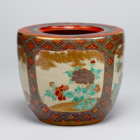Japanese Gallery (Honkan) Room 14
October 6, 2020 (Tue) - November 29, 2020 (Sun)
This thematic exhibition introduces tea bowls from the 17th century; the beginning of the Edo period (1603–1868). After the Azuchi-Momoyama (1567–1603) period, a time of experimental potters whose bowls have been described as audacious, the tea ceremony spread to various layers of society including the samurai, the imperial family and townspeople, who mutually influenced one another and further developed the tea ceremony in the Edo period. The appearance of ceramics in this new era embodies the tastes of these new practitioners and can be called harmonious.

